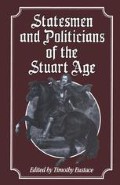Abstract
When, in January 1642, Charles I attempted to arrest five members of the House of Commons, he was acting according to the conspiracy theory of political opposition: a fundamentally loyal Parliament had been seduced into confrontation with the King by a number of forceful, ambitious and dangerous individuals; remove these individuals and opposition would evaporate. Charles may have been criticised since for failing to see the broad basis of opposition in Parliament, yet his opponents saw the problems of the Personal Rule in the same light — the work of misguided individuals corrupting potentially sound institutions — and they had already attacked, and in one case destroyed, its agents. How important, though, were the parliamentary leaders to the apparent success of the Long Parliament in its first two years? How far was Charles’s view of conspiracy a valid one?
Preview
Unable to display preview. Download preview PDF.
Bibliography
There is no good biography of Pym. The article by Gardiner in the Dictionary of National Biography provides the best introduction, along with the general accounts by I. Roots in The Great Rebellion (1966) and P. Zagorin in The Court and the Country (1969). For the 1620s an invaluable source of information and ideas is Conrad Russell’s essay ‘The Parliamentary Career of John Pym, 1621–29’, in The English Commonwealth 1547–1640: Essays in Politics and Society Presented to Joel Hurstfield (Leicester, 1979), and further detail is contained in Russell’s Parliaments and English Politics 1621–29 (Oxford, 1979). For the development of Arminianism and religious ideas in the 1620s see the essay by Nicholas Tyacke, ‘Puritanism, Arminianism and Counter-revolution’, in The Origins of the English Civil War, ed. C. Russell (1973), and Peter White’s ‘The Rise of Arminianism Reconsidered’, Past and Present, 1983. The only useful material on the 1630s is in J. H. Hexter, The Reign of King Pym (Cambridge, Mass., 1941), which also discusses the politics and management of the Middle Group in the Long Parliament. Pym’s relations with London are mentioned in V. Pearl, London and the Outbreak of the Puritan Revolution (Oxford, 1961). Anthony Fletcher’s detailed study, The Outbreak of the English Civil War (1981) gives a full account of Pym’s activities in the early days of the Long Parliament. His financial programme is covered in Russell’s essay ‘Parliament and the King’s Finances’, in Origins of the English Civil War. Pym’s role as a parliamentary manager and committee man are dealt with in three articles by L. Glow: ‘Pym and Parliament’, Journal of Modern History, 1964; ‘The Committee Men in the Long Parliament’, Historical Journal, 1965; and ‘The Committee of Safety’, English Historical Review, 1965. J. S. Morrill’s The Revolt of the Provinces (1976) contains details of the parliamentary war machine on the local level. Articles in the Journal of Modern History, 1977, provide some interesting comments on the Long Parliament and Pym’s role.
Editor information
Copyright information
© 1985 Jonathan Watts
About this chapter
Cite this chapter
Watts, J. (1985). John Pym. In: Eustace, T. (eds) Statesmen and Politicians of the Stuart Age. Palgrave, London. https://doi.org/10.1007/978-1-349-17874-2_6
Download citation
DOI: https://doi.org/10.1007/978-1-349-17874-2_6
Publisher Name: Palgrave, London
Print ISBN: 978-0-333-31827-0
Online ISBN: 978-1-349-17874-2
eBook Packages: Palgrave Literature & Performing Arts CollectionLiterature, Cultural and Media Studies (R0)

